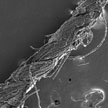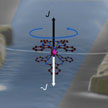Showing Spotlights 49 - 56 of 319 in category All (newest first):
 Thanks to nanotechnology, medical research is moving quickly towards a future where intelligent medical implants can continuously monitor their condition inside the body and autonomously respond to changes such as infection by releasing anti-inflammatory agents. A recent review discusses present and prospective implantable sensors incorporating nanostructured carbon allotropes. The authors describe various applications with an in-depth look at the implantable sensors from the viewpoints of nanomedicine, materials science, nanobiotechnology, and sensor design, both present and future.
Thanks to nanotechnology, medical research is moving quickly towards a future where intelligent medical implants can continuously monitor their condition inside the body and autonomously respond to changes such as infection by releasing anti-inflammatory agents. A recent review discusses present and prospective implantable sensors incorporating nanostructured carbon allotropes. The authors describe various applications with an in-depth look at the implantable sensors from the viewpoints of nanomedicine, materials science, nanobiotechnology, and sensor design, both present and future.
Sep 5th, 2013
 Conventional carbon-fiber electrodes have been the material of choice for identifying the chemical nature of neurotransmitters in the brain. Unfortunately, they have some limitations that leave some of the molecules that researchers are interested in just out of our reach. Further miniaturization of biologically compatible, carbon based electrode materials to the nanoscale promises to enhance the very characteristics that made microelectrodes so transformative in the first place, enabling high speed measurements in discrete spatial locations.
Conventional carbon-fiber electrodes have been the material of choice for identifying the chemical nature of neurotransmitters in the brain. Unfortunately, they have some limitations that leave some of the molecules that researchers are interested in just out of our reach. Further miniaturization of biologically compatible, carbon based electrode materials to the nanoscale promises to enhance the very characteristics that made microelectrodes so transformative in the first place, enabling high speed measurements in discrete spatial locations.
Sep 3rd, 2013
 In new work, researchers have demonstrated that flexible cotton threads can be used as a platform to fabricate a cable-type supercapacitor. Wearable electronics will go far beyond just very small electronic devices or wearable, flexible computers. Not only will these devices be embedded in textile substrates but an electronics device or system could ultimately become the fabric itself. Supercapacitors with a cable-type architecture could lead to flexible energy storage devices that can remove traditional restriction and achieve a subversive technology that could open up a path for design innovation.
In new work, researchers have demonstrated that flexible cotton threads can be used as a platform to fabricate a cable-type supercapacitor. Wearable electronics will go far beyond just very small electronic devices or wearable, flexible computers. Not only will these devices be embedded in textile substrates but an electronics device or system could ultimately become the fabric itself. Supercapacitors with a cable-type architecture could lead to flexible energy storage devices that can remove traditional restriction and achieve a subversive technology that could open up a path for design innovation.
Aug 29th, 2013
 With the semiconductor industry still on the path of Moore's law, researchers have already been toying with single-molecule electronics and molecular memory to push miniaturization of electronics to its limit. However, with electrical gadgets and devices getting increasingly smaller and functionally more powerful, the current density flowing through the copper and gold conductors in these devices has been exponentially increasing. Therefore, electrical conductors with higher current density tolerance are in huge demand and recent research has addressed this issue.
With the semiconductor industry still on the path of Moore's law, researchers have already been toying with single-molecule electronics and molecular memory to push miniaturization of electronics to its limit. However, with electrical gadgets and devices getting increasingly smaller and functionally more powerful, the current density flowing through the copper and gold conductors in these devices has been exponentially increasing. Therefore, electrical conductors with higher current density tolerance are in huge demand and recent research has addressed this issue.
Aug 6th, 2013
 Microbial fuel cells are a prime example of environmental biotechnology that turns the treatment of organic wastes into a source of electricity. In microbial fuel cells, the naturally occurring decomposing pathways of electrogenic bacteria are used to both clean water and produce electricity by oxidizing biological compounds from wastewater and other liquid wastes, even urine. Researchers have now demonstrated a sustainable and practical design for a micro-sized microbial fuel cell.
Microbial fuel cells are a prime example of environmental biotechnology that turns the treatment of organic wastes into a source of electricity. In microbial fuel cells, the naturally occurring decomposing pathways of electrogenic bacteria are used to both clean water and produce electricity by oxidizing biological compounds from wastewater and other liquid wastes, even urine. Researchers have now demonstrated a sustainable and practical design for a micro-sized microbial fuel cell.
Aug 1st, 2013
 Direct visualization and manipulation of individual carbon nanotubes (CNTs) in ambient conditions is of great significance for their characterizations and applications. However, the direct visualization, location, and manipulation of individual CNTs is extremely difficult due to their nanoscale diameters. The observation of individual CNTs usually requires electron microscopes under high vacuum. Researchers now have proposed a facile way to realize optical visualization of individual carbon nanotubes and, based on that, macroscale manipulation of individual carbon nanotubes that could be carried out under an optical microscope.
Direct visualization and manipulation of individual carbon nanotubes (CNTs) in ambient conditions is of great significance for their characterizations and applications. However, the direct visualization, location, and manipulation of individual CNTs is extremely difficult due to their nanoscale diameters. The observation of individual CNTs usually requires electron microscopes under high vacuum. Researchers now have proposed a facile way to realize optical visualization of individual carbon nanotubes and, based on that, macroscale manipulation of individual carbon nanotubes that could be carried out under an optical microscope.
Jul 22nd, 2013
 Electronics will undergo revolutionary changes as the relatively novel disciplines of spintronics, nanoelectronics, and quantum computing come of age. A fundamental link between these fields can be established using molecular magnetic materials and, in particular, single-molecule magnets. Researchers have now demonstrated how to noninvasively graft a single-molecule magnet onto a carbon nanotube nanoelectromechanical system and probe the molecular nanomagnet with the carbon nanotube's mechanical motion.
Electronics will undergo revolutionary changes as the relatively novel disciplines of spintronics, nanoelectronics, and quantum computing come of age. A fundamental link between these fields can be established using molecular magnetic materials and, in particular, single-molecule magnets. Researchers have now demonstrated how to noninvasively graft a single-molecule magnet onto a carbon nanotube nanoelectromechanical system and probe the molecular nanomagnet with the carbon nanotube's mechanical motion.
Jul 19th, 2013
 Liquid-solid phase transitions can be an attractive route for the temperature regulation of electrical and/or thermal properties because of the availability of materials with a wide range of phase transition temperatures. Achieving different magnitudes of enhancement in solid and liquid state is difficult to explain from a theoretical point of view. When researchers made similar experiments using single-walled carbon nanotubes as the additives, they noticed much higher thermal conductivity improvement than the evidence available in existing literature. This is something they never anticipated to happen and they were quite surprised with the enhancement seen.
Liquid-solid phase transitions can be an attractive route for the temperature regulation of electrical and/or thermal properties because of the availability of materials with a wide range of phase transition temperatures. Achieving different magnitudes of enhancement in solid and liquid state is difficult to explain from a theoretical point of view. When researchers made similar experiments using single-walled carbon nanotubes as the additives, they noticed much higher thermal conductivity improvement than the evidence available in existing literature. This is something they never anticipated to happen and they were quite surprised with the enhancement seen.
Jul 17th, 2013
 Thanks to nanotechnology, medical research is moving quickly towards a future where intelligent medical implants can continuously monitor their condition inside the body and autonomously respond to changes such as infection by releasing anti-inflammatory agents. A recent review discusses present and prospective implantable sensors incorporating nanostructured carbon allotropes. The authors describe various applications with an in-depth look at the implantable sensors from the viewpoints of nanomedicine, materials science, nanobiotechnology, and sensor design, both present and future.
Thanks to nanotechnology, medical research is moving quickly towards a future where intelligent medical implants can continuously monitor their condition inside the body and autonomously respond to changes such as infection by releasing anti-inflammatory agents. A recent review discusses present and prospective implantable sensors incorporating nanostructured carbon allotropes. The authors describe various applications with an in-depth look at the implantable sensors from the viewpoints of nanomedicine, materials science, nanobiotechnology, and sensor design, both present and future.
 Subscribe to our Nanotechnology Spotlight feed
Subscribe to our Nanotechnology Spotlight feed





